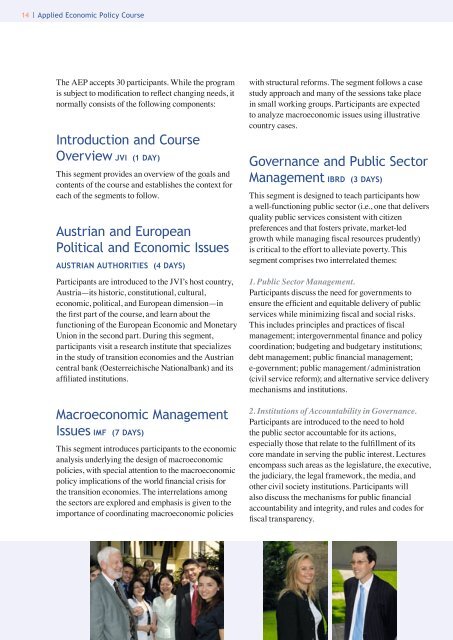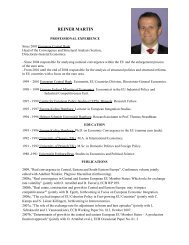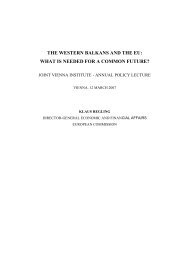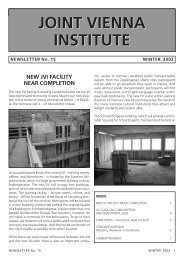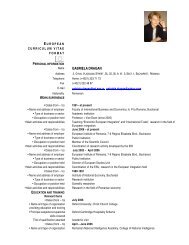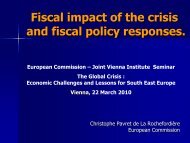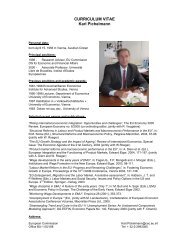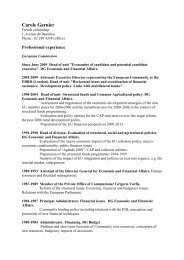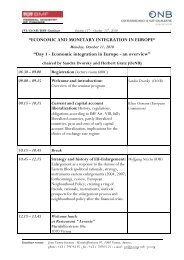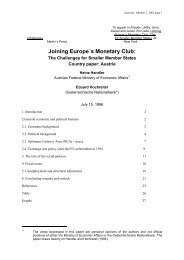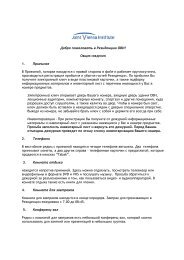Program 2010 - Joint Vienna Institute
Program 2010 - Joint Vienna Institute
Program 2010 - Joint Vienna Institute
- No tags were found...
You also want an ePaper? Increase the reach of your titles
YUMPU automatically turns print PDFs into web optimized ePapers that Google loves.
14 | Applied Economic Policy Course<br />
The AEP accepts 30 participants. While the program<br />
is subject to modification to reflect changing needs, it<br />
normally consists of the following components:<br />
Introduction and Course<br />
Overview JVI (1 day)<br />
This segment provides an overview of the goals and<br />
contents of the course and establishes the context for<br />
each of the segments to follow.<br />
Austrian and European<br />
Political and Economic Issues<br />
Austrian Authorities (4 days)<br />
Participants are introduced to the JVI’s host country,<br />
Austria—its historic, constitutional, cultural,<br />
economic, political, and European dimension—in<br />
the first part of the course, and learn about the<br />
functioning of the European Economic and Monetary<br />
Union in the second part. During this segment,<br />
participants visit a research institute that specializes<br />
in the study of transition economies and the Austrian<br />
central bank (Oesterreichische Nationalbank) and its<br />
affiliated institutions.<br />
Macroeconomic Management<br />
Issues IMF (7 days)<br />
This segment introduces participants to the economic<br />
analysis underlying the design of macroeconomic<br />
policies, with special attention to the macroeconomic<br />
policy implications of the world financial crisis for<br />
the transition economies. The interrelations among<br />
the sectors are explored and emphasis is given to the<br />
importance of coordinating macroeconomic policies<br />
with structural reforms. The segment follows a case<br />
study approach and many of the sessions take place<br />
in small working groups. Participants are expected<br />
to analyze macroeconomic issues using illustrative<br />
country cases.<br />
Governance and Public Sector<br />
Management IBRD (3 days)<br />
This segment is designed to teach participants how<br />
a well-functioning public sector (i.e., one that delivers<br />
quality public services consistent with citizen<br />
preferences and that fosters private, market-led<br />
growth while managing fiscal resources prudently)<br />
is critical to the effort to alleviate poverty. This<br />
segment comprises two interrelated themes:<br />
1. Public Sector Management.<br />
Participants discuss the need for governments to<br />
ensure the efficient and equitable delivery of public<br />
services while minimizing fiscal and social risks.<br />
This includes principles and practices of fiscal<br />
management; intergovernmental finance and policy<br />
coordination; budgeting and budgetary institutions;<br />
debt management; public financial management;<br />
e-government; public management / administration<br />
(civil service reform); and alternative service delivery<br />
mechanisms and institutions.<br />
2. Institutions of Accountability in Governance.<br />
Participants are introduced to the need to hold<br />
the public sector accountable for its actions,<br />
especially those that relate to the fulfillment of its<br />
core mandate in serving the public interest. Lectures<br />
encompass such areas as the legislature, the executive,<br />
the judiciary, the legal framework, the media, and<br />
other civil society institutions. Participants will<br />
also discuss the mechanisms for public financial<br />
accountability and integrity, and rules and codes for<br />
fiscal transparency.


